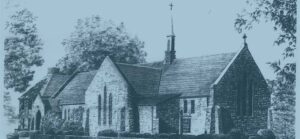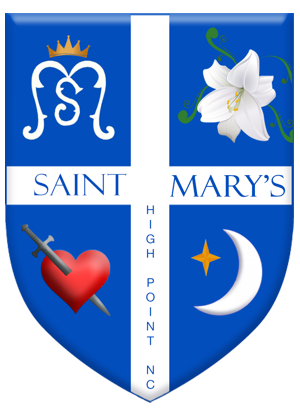Our History
 On May 3, 1882, in the home of English gold-mining engineer, Josiah Remfry, fifteen Anglican communicants met with Bishop Lyman of the Diocese of North Carolina to organize St. James Mission, later to be called St. Mary’s. The first priest was Alfred Stubbs, who was at the time rector of what is now Holy Trinity in Greensboro.
On May 3, 1882, in the home of English gold-mining engineer, Josiah Remfry, fifteen Anglican communicants met with Bishop Lyman of the Diocese of North Carolina to organize St. James Mission, later to be called St. Mary’s. The first priest was Alfred Stubbs, who was at the time rector of what is now Holy Trinity in Greensboro.
Observing the floundering efforts to raise money to build a church was a remarkable woman, Mrs. C. A. Hamner. Although not an Episcopalian, she maintained that it would be to everyone’s advantage to have an Episcopal Church built in High Point. She not only spearheaded various fund drives, but, with her husband, (and unknown to the parishioners at the time), actually financed the cost of erecting the new church. She was confirmed in 1887, and soon became parish treasurer; her husband was confirmed in 1892.
The cornerstone of the little brick church was laid on July 20, 1890, at the corner of Kivett Avenue, with an entrance facing Hayden Place. The building was 60 feet long and 24 feet wide, with a seating capacity of 124. Consecrated on October 17, 1912, by Bishop Joseph Cheshire, St. Mary’s was sometimes a mission, sometimes a parish, but always small and pressed for money. The present building dates from 1928, and set into the narthex wall is the cornerstone of that first little brick building on Hayden Place.
 With the coming of the Great Depression, the parishioners faced renewed work and sacrifice. The organ mortgage was paid off by the Church Women from the operation of a food stand in the summer of 1931 on the construction site of Ferndale Junior High School; a few church men even mortgaged their own homes in order to renew the property loan, which was threatened with foreclosure by the bank and insurance companies that held the mortgage. Finally, in 1947, the mortgage debt was paid.
With the coming of the Great Depression, the parishioners faced renewed work and sacrifice. The organ mortgage was paid off by the Church Women from the operation of a food stand in the summer of 1931 on the construction site of Ferndale Junior High School; a few church men even mortgaged their own homes in order to renew the property loan, which was threatened with foreclosure by the bank and insurance companies that held the mortgage. Finally, in 1947, the mortgage debt was paid.
During wartime (World Wars I and II, Korea, and Vietnam) the people of the church performed all those tasks that mixed mission work with helping a threatened country; Civil Defense, Emergency Canteen, Red Cross bandage rolling, United Nations clothing drive, Philippine war relief, gifts for hospitalized veterans, and other charitable works.
After World War II, general national prosperity brought renewed growth to St. Mary’s, and its first enduring financial security. It was during the 1940s that a strong ministry of music developed. Gardner Nichols, an organist and choirmaster, organized the St. Dunstan’s Boys’ Choir. This group of about 20 boys, ages 6 to 15, gave four annual concerts of both sacred and secular music, even acting out an entire opera in full costume! The boys took their show on the road throughout North Carolina, and once all the way to New York City. The boys’ choir was later combined with the men’s choir.
In the 1960s there was only an adult choir, although in recent years the music program has grown to include the adult choir, three children’s choirs, a handbell choir, and a contemporary music group. A new organ was purchased in 1988, and in the last several years CD’s of our choral programs have been made available through the church.
From 1953 to 1980 the Rev. William P. Price was rector. During his tenure, property was purchased next to the church, and an education building was completed in 1962. Between the two buildings a columbarium was constructed as an addition to the Memorial Garden. Such a church site for interment of ashes was unique in High Point at the time. The most recent building project was construction of a parking lot in 1993.
Outreach can be much more daring than offering good music to a community, as those who lived through the ’60s know full well! Those were the years the Episcopal Church Women ran a kindergarten for underprivileged children (no public kindergarten then!) The civil rights revolution had begun, and in June 1963, St. Mary’s Vestry made a statement of support for merchants and businessmen who would open their places of business to African-Americans.
In 1968, St. Mary’s held a summer school called Venture ’68, that offered assistance to the African-American rising seniors now absorbed into previously all-white high schools. In 1969 St Mary’s shared with an African-American congregation the sponsorship of a non-profit organization for a low cost housing project through the FHA. Also in the ’60s land was purchased for a mission and 150 communicants volunteered to go to the new church, to be named St. Christopher’s.
In the ’70s two revolutions were taking place. Women joined African-Americans in asking for equal rights. Not only women, but also men, were playing new roles in church liturgy. A radical view of the ministry of the laity was getting started. These changes, along with a revised Book of Common Prayer, were difficult for some members, but the parish managed to stay together. In 2001 St. Mary’s has a woman deacon, the Rev. Delia Higgins, ordained in June 1989, and a vestry with six men and six women. Men and women serve as lay Eucharistic ministers, lay readers, and ushers. Boys and girls are crucifers and acolytes.
From January 1981 to March 2008, the Rev. Dr. Glenn Busch was rector of our church. He is now Rector Emeritus. Under Dr. Busch’s leadership, outreach continued through such projects as resettling a refugee family, allowing the Piedmont School (for children with learning disabilities) to use the Education Building for daily and nightly activities, and accommodating various social programs’ need for meeting space. In 1988 the parish began its first involvement in building homes for Habitat for Humanity, culminating in St. Mary’s financing one house. A lighthearted community outreach effort was the beginning in 1988 of a Halloween celebration called GhostWalk, sponsored by the Episcopal Church Women.
The Rev. David Umphlett was rector of our church from 2009- September 2020. During his tenure, the long-planned capital expansion of the church campus came to completion. The 20,000 square foot Community Life Center was completed in 2012 and the 16,000 square foot Education and Administration Building was finished in November 2015.
The parish continues to be very supportive of Open Door Ministries, West End Ministries, and other needs in our community.
